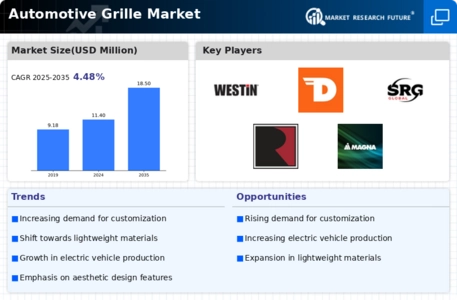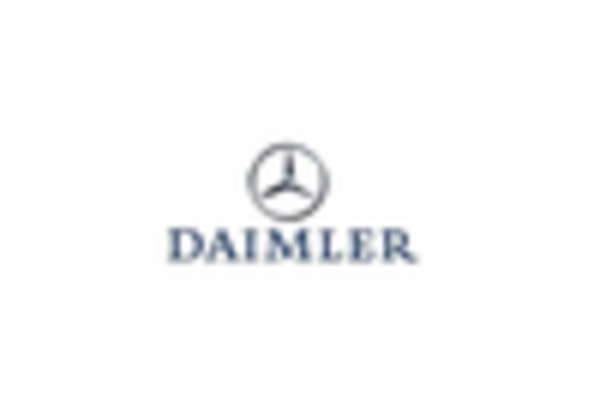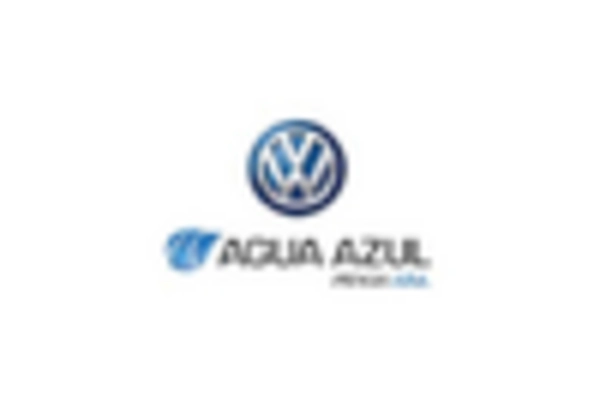Increasing Focus on Aesthetic Appeal
The Automotive Grille Market is witnessing a growing emphasis on aesthetic appeal as consumers increasingly prioritize vehicle design and personalization. Grilles serve as a focal point in vehicle styling, and manufacturers are responding by offering a wider array of designs, finishes, and customization options. This trend is particularly evident in the luxury and performance vehicle segments, where distinctive grille designs can significantly enhance brand identity and consumer attraction. Market data indicates that the demand for customized grilles is expected to rise, with a projected increase of approximately 7% in the next few years. As automakers strive to differentiate their products in a competitive landscape, the integration of unique and visually appealing grilles into the Automotive Grille Market is likely to become a key strategy for attracting discerning consumers.
Growth of Electric and Hybrid Vehicles
The Automotive Grille Market is poised for transformation due to the rapid growth of electric and hybrid vehicles. As these vehicles become more prevalent, the design and functionality of grilles are evolving to meet the unique requirements of electric powertrains. Unlike traditional internal combustion engines, electric vehicles often require less cooling, leading to a shift in grille design towards more streamlined and closed-off configurations. Market analysis suggests that the electric vehicle segment is expected to grow at a compound annual growth rate of over 20% in the coming years. This shift presents both challenges and opportunities for the Automotive Grille Market, as manufacturers must innovate to create grilles that not only enhance the aesthetic appeal of electric vehicles but also contribute to their aerodynamic efficiency. The adaptation to this new market reality is likely to redefine the role of grilles in modern automotive design.
Rising Demand for Lightweight Materials
The Automotive Grille Market is experiencing a notable shift towards lightweight materials, driven by the automotive sector's focus on enhancing fuel efficiency and reducing emissions. Manufacturers are increasingly adopting materials such as aluminum and advanced composites, which not only reduce the overall weight of vehicles but also improve performance. According to recent data, the use of lightweight materials in automotive applications is projected to grow at a compound annual growth rate of approximately 8% over the next five years. This trend is likely to influence the design and production of automotive grilles, as manufacturers seek to align with regulatory standards and consumer preferences for more efficient vehicles. Consequently, the integration of lightweight materials into the Automotive Grille Market may lead to innovative designs that cater to both aesthetic and functional requirements.
Regulatory Compliance and Safety Standards
The Automotive Grille Market is increasingly influenced by stringent regulatory compliance and safety standards imposed by governments worldwide. These regulations often dictate specific design and performance criteria for vehicle components, including grilles, to ensure safety and environmental sustainability. For instance, regulations regarding pedestrian safety have led to the development of grilles that minimize injury risk in the event of a collision. Additionally, emissions standards are pushing manufacturers to design grilles that enhance engine cooling efficiency while maintaining aerodynamic performance. As a result, the Automotive Grille Market is expected to adapt to these evolving regulations, potentially leading to innovations that not only comply with safety standards but also improve overall vehicle performance. This compliance-driven approach may foster a more competitive environment among manufacturers, encouraging continuous improvement in grille design and functionality.
Technological Innovations in Grille Design
Technological advancements are playing a pivotal role in shaping the Automotive Grille Market. Innovations such as active grille shutters and integrated sensors are becoming increasingly prevalent, enhancing vehicle aerodynamics and improving fuel efficiency. These technologies allow for dynamic adjustments to the grille based on driving conditions, which can optimize airflow and engine cooling. As a result, the market for technologically advanced grilles is expected to expand significantly, with estimates suggesting a growth rate of around 6% annually. This evolution not only meets the demands of modern consumers for enhanced performance but also aligns with the automotive industry's broader goals of sustainability and efficiency. The incorporation of such technologies into the Automotive Grille Market is likely to redefine traditional grille functionalities, making them integral components of vehicle performance.

















Leave a Comment